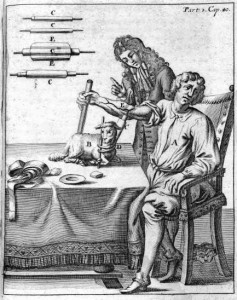 In honor of its 350th anniversary, British academy the Royal Society has created a timeline of the past 350 years of scientific discovery as seen through 60 original papers marking some of the most important milestones in the history of science.
In honor of its 350th anniversary, British academy the Royal Society has created a timeline of the past 350 years of scientific discovery as seen through 60 original papers marking some of the most important milestones in the history of science.
The site is called Trailblazing, and it’s an easily navigable, easily browsable voyage of discovery through subjects as diverse as Boyle’s paper describing the first live blood transfusion from dog to dog in 1666, to the discovery of a comet by first recognized female scientist Caroline Herschel in 1794, to solar flares observed from the Hintori satellite in 1991.
The creators of Trailblazing say it is a “go-at-your-own-pace” virtual journey through science which the Royal Society hopes will inspire members of the public to see science as part of everyday life and culture.
Martin Rees, president of the Royal Society, said the papers showed “a ceaseless quest by scientists over the centuries…to test and build on our knowledge of humankind and the universe.”
“They represent those thrilling moments when science allows us to understand better and to see further,” he added.
It also showcases how science has been done almost unawares, like Captain James Cook who figured out way back in 1776 how to prevent scurvy in his men by feeding them pickled cabbage, lemons and malt.
The 60 articles were chosen from among 60,000 published by the Royal Society, including in august journals like Philosophical Transactions, the oldest continually published science journal in the world.
The Royal Society will be celebrating its anniversary in many other ways as well. There will be a nine-day science and arts festival next summer, a variety of lectures open to the public, debates at the Society’s London headquarters, and partnership exhibits with museums and galleries that spotlight the achievement of science as a discipline and individual luminaries of the field.
This is awesome. I checked out the Cook stuff. Fascinating. Strange that scurvy lingered on so long after he discovered the cure.
It is strange. I suppose other ship captains, the navy, the merchant marine didn’t pay attention to scientific publications. Or maybe they just didn’t buy that there was a connection between nutrition and illness.
P.S. – My mom got a nasty case of Hepatitis from some mussels once.
In those old docs (the transfusion ones, for example) in a lot of cases the letter ‘s’ is replaced by something that looks like a cross between a capital ‘S’ and a lower case ‘f.’ About half the words, at least, and it seems to occur more in words with multiple ‘s’ letters. In those words one of the letters will be an actual ‘s’ and the other is replaced with this mystery letter. I know it isn’t a wonky capital ‘S’ because it occurs mid-word at times.
What the heck is that?
Thanks in advance, oh knowledgeable readers of Livius’ prose :notworthy: .
It’s called a medial s. It’s only used with a lowercase s in the beginning or middle of the word, so any ending esses were the normal short form we’re accustomed to today.
It’s a holdover from Roman cursive and fell out of use around 1800 or so.
Thanks Livius! :hattip: